Used automotive vehicle retailer Carmax (NYSE:KMX) missed analysts' expectations in Q1 CY2024, with revenue down 1.7% year on year to $5.63 billion. It made a GAAP profit of $0.32 per share, down from its profit of $0.44 per share in the same quarter last year.
CarMax (KMX) Q1 CY2024 Highlights:
- Revenue: $5.63 billion vs analyst estimates of $5.81 billion (3.2% miss, and both used and wholesale vehicle revenue missed individually)
- EPS: $0.32 vs analyst expectations of $0.45 (28.8% miss)
- Gross Margin (GAAP): 10.4%, down from 10.7% in the same quarter last year
- Free Cash Flow of $199.8 million is up from -$482 million in the same quarter last year
- Same-Store Sales were down 2% year on year
- Store Locations: 245 at quarter end, increasing by 5 over the last 12 months
- Market Capitalization: $12.52 billion
Known for its transparent, customer-centric approach and wide selection of vehicles, Carmax (NYSE:KMX) is the largest automotive retailer in the United States.
Founded in 1993, the company is headquartered in Richmond, Virginia, and operates over 200 stores across the country. Carmax offers a unique car buying experience by providing customers with a no-haggle, no-pressure environment where they can browse a wide selection of high-quality used cars, and take them for test drives without a salesperson. Carmax also offers a range of services such as financing, warranties, and trade-ins.
The core customer for Carmax is someone who is looking for a used car but wants a hassle-free, transparent buying process. Typically, these customers are looking for a car that is less than five years old and has low mileage. Carmax addresses their needs by offering a wide selection of high-quality used cars at competitive prices. Customers can also take advantage of the company's financing options, which include pre-approval and a range of payment plans.
The average Carmax store is around 50,000 square feet and is located in suburban or urban areas. The stores are laid out in a way that makes it easy for customers to browse the cars and take them for test drives. The cars are organized by make and model, and customers can easily find information about each car's features, history, and pricing.
Carmax launched its e-commerce presence in 2019. Customers can browse and purchase cars online, as well as schedule a test drive and arrange for delivery or pickup. The company's online platform also includes a range of resources such as car reviews, buying guides, and financing calculators.
An interesting fact about Carmax is that the company has been consistently ranked as one of the best companies to work for by Fortune magazine. This is in part due to the company's commitment to employee development and training, as well as its focus on creating a positive work culture. Carmax also supports various community initiatives, such as providing funding for education and job training programs.
Vehicle Retailer
Buying a vehicle is a big decision and usually the second-largest purchase behind a home for many people, so retailers that sell new and used cars try to offer selection, convenience, and customer service to shoppers. While there is online competition, especially for research and discovery, the vehicle sales market is still very fragmented and localized given the magnitude of the purchase and the logistical costs associated with moving cars over long distances. At the end of the day, a large swath of the population relies on cars to get from point A to point B, and vehicle sellers are acutely aware of this need.
Competitors in the auto retail space include AutoNation (NYSE:AN), Carvana (NYSE:CVNA), Group 1 Automotive (NYSE:GPI), and Lithia Motors (NYSE:LAD).
Sales Growth
CarMax is one of the larger companies in the consumer retail industry and benefits from economies of scale, enabling it to gain more leverage on fixed costs and offer consumers lower prices.
As you can see below, the company's annualized revenue growth rate of 7.9% over the last five years was mediocre as it opened new stores and expanded its reach.
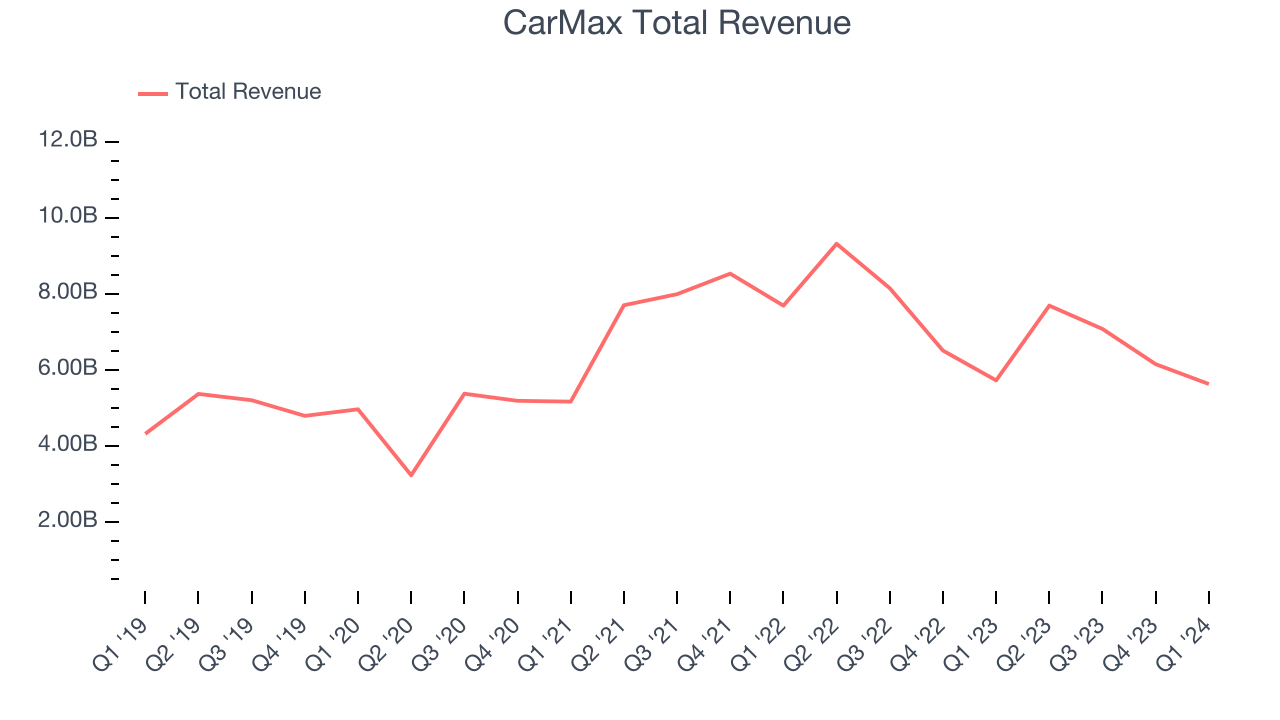
This quarter, CarMax missed Wall Street's estimates and reported a rather uninspiring 1.7% year-on-year revenue decline, generating $5.63 billion in revenue. Looking ahead, Wall Street expects sales to grow 2.3% over the next 12 months, an acceleration from this quarter.
Number of Stores
When a retailer like CarMax is opening new stores, it usually means it's investing for growth because demand is greater than supply. Since last year, CarMax's store count increased by 5 locations, or 2.1%, to 245 total retail locations in the most recently reported quarter.
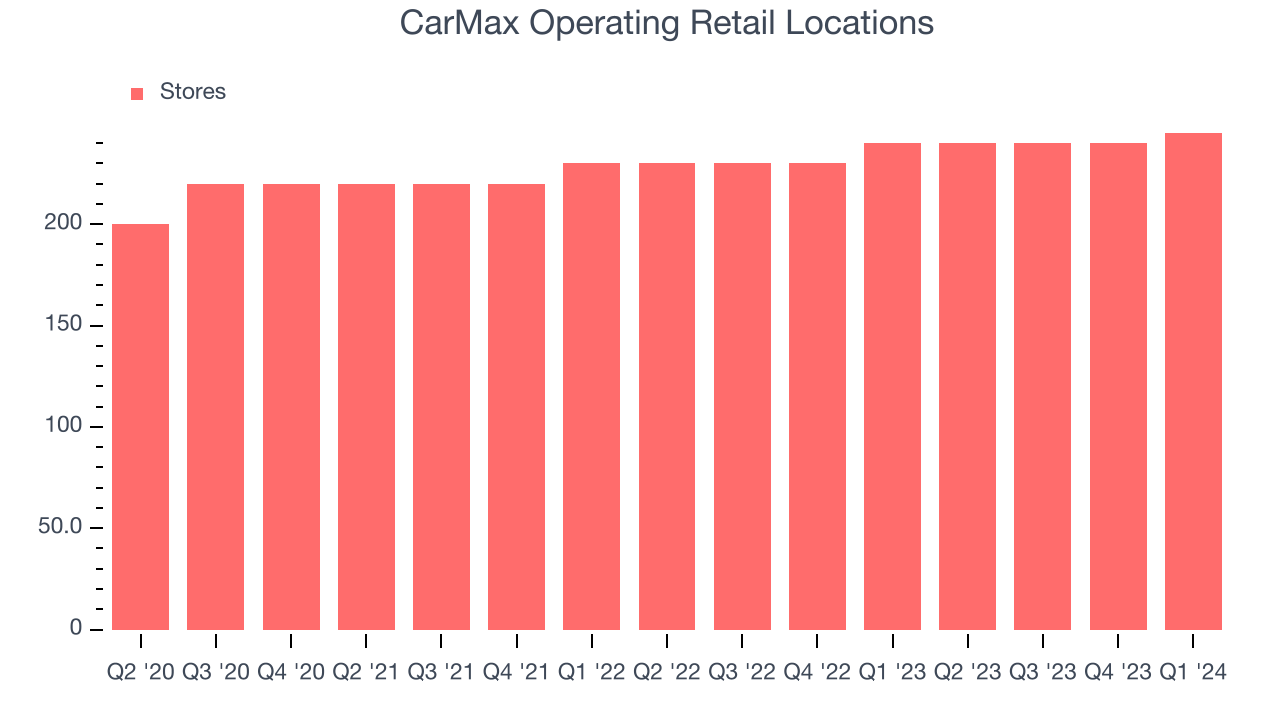
Over the last two years, the company has generally opened new stores and averaged 4.1% annual growth in its physical footprint, which is decent and on par with the broader sector. With an expanding store base and demand, revenue growth can come from multiple vectors: sales from new stores, sales from e-commerce, or increased foot traffic and higher sales per customer at existing stores.
Same-Store Sales
CarMax's demand has been shrinking over the last eight quarters, and on average, its same-store sales have declined by 8.8% year on year. This performance is quite concerning and the company should reconsider its strategy before investing its precious capital into new store buildouts.
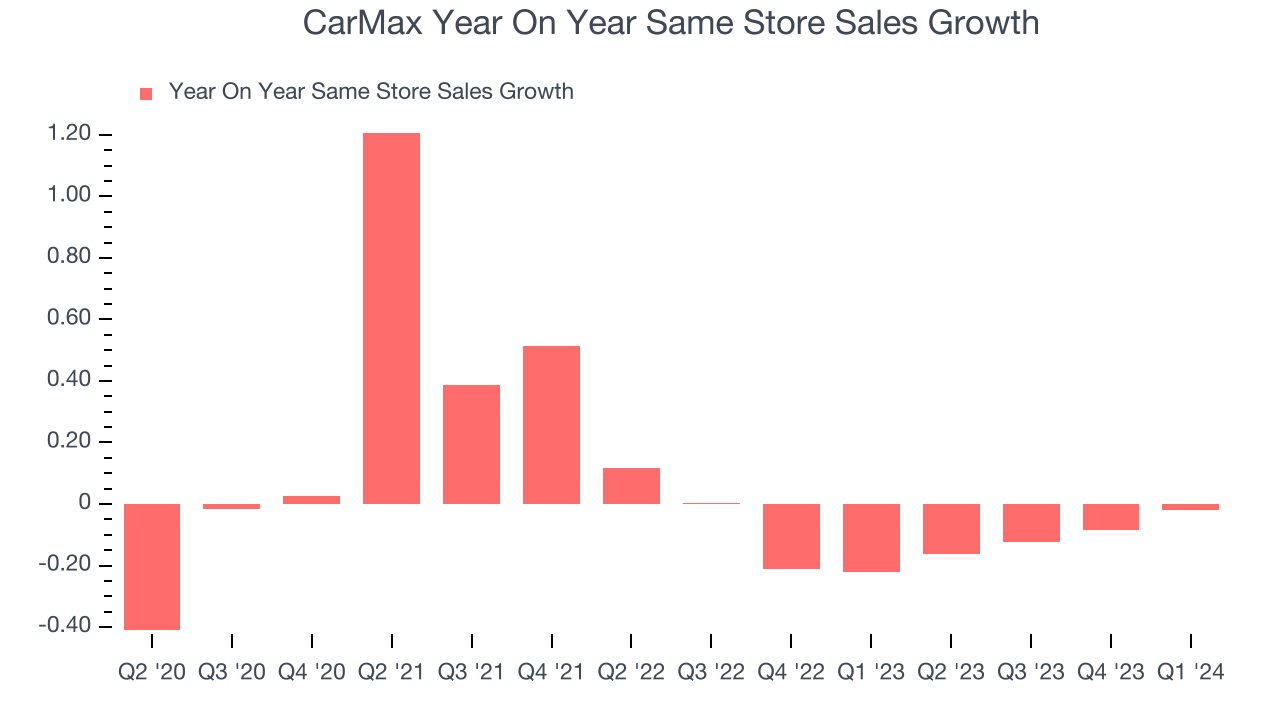
In the latest quarter, CarMax's same-store sales fell 2% year on year. This decrease was an improvement from the 22% year-on-year decline it posted 12 months ago. It's always great to see a business improve its prospects.
Gross Margin & Pricing Power
We prefer higher gross margins because they not only make it easier to generate more operating profits but also indicate product differentiation, negotiating leverage, and pricing power.
CarMax has poor unit economics for a retailer, leaving it with little room for error if things go awry. As you can see below, it's averaged a 9.8% gross margin over the last two years. This means the company makes $0.10 for every $1 in revenue before accounting for its operating expenses.
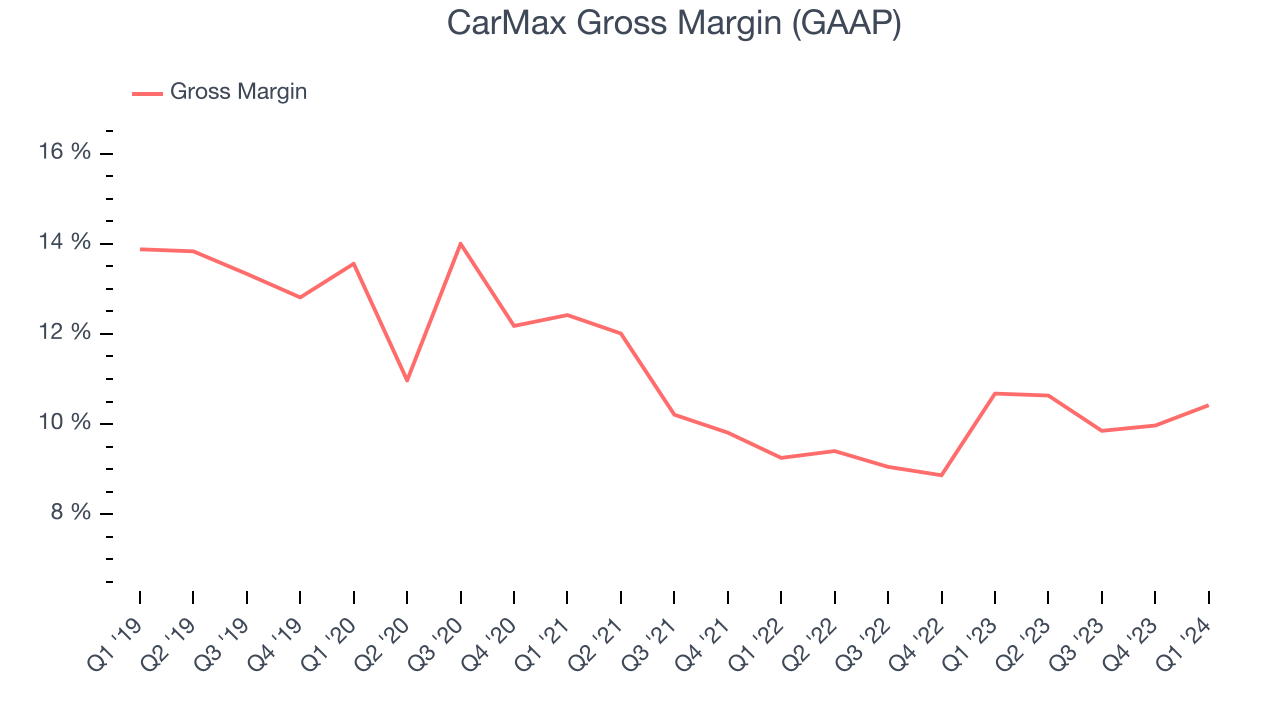
CarMax's gross profit margin came in at 10.4% this quarter, flat with the same quarter last year. This steady margin stems from its efforts to keep prices low for consumers and signals that it has stable input costs (such as freight expenses to transport goods).
Operating Margin
Operating margin is an important measure of profitability for retailers as it accounts for all expenses keeping the lights on, including wages, rent, advertising, and other administrative costs.
In Q1, CarMax generated an operating profit margin of 1.6%, in line with the same quarter last year. This indicates the company's costs have been relatively stable.
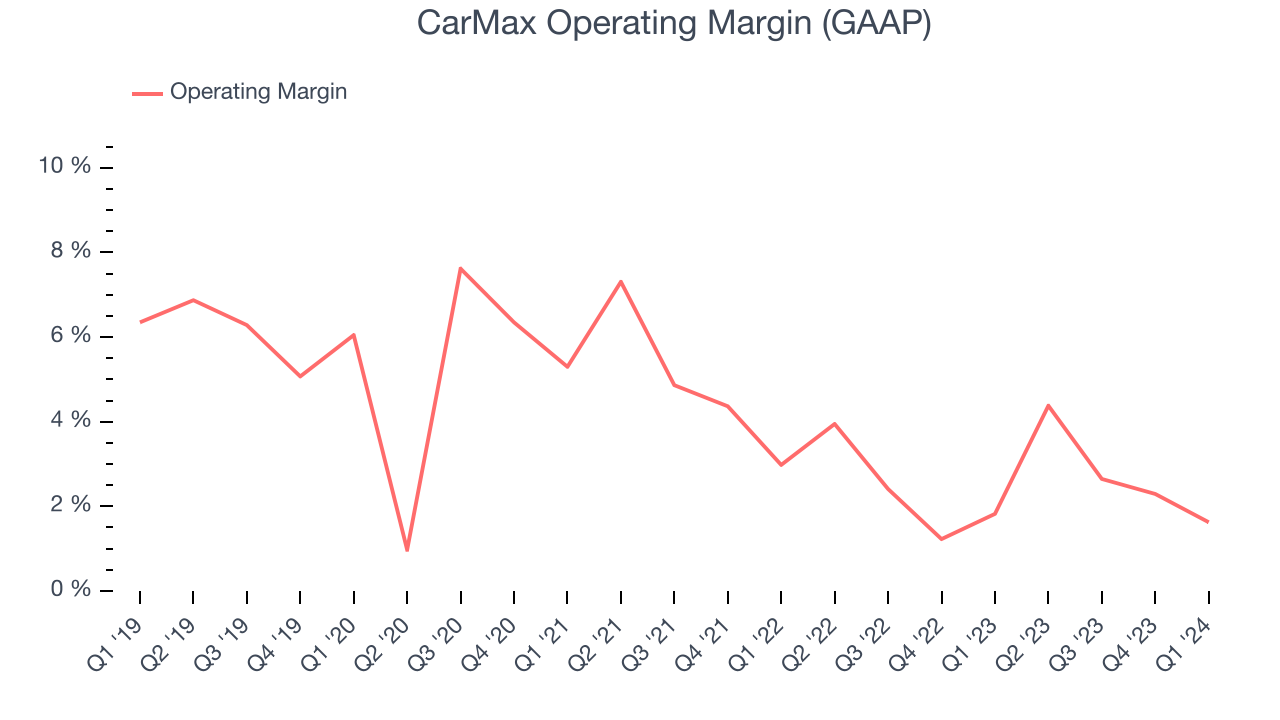
Zooming out, CarMax was profitable over the last two years but held back by its large expense base. Its average operating margin of 2.7% has been paltry for a consumer retail business. Its margin has also seen few fluctuations, meaning it will take a big change to improve profitability.
EPS
These days, some companies issue new shares like there's no tomorrow. That's why we like to track earnings per share (EPS) because it accounts for shareholder dilution and share buybacks.
In Q1, CarMax reported EPS at $0.32, down from $0.44 in the same quarter a year ago. This print unfortunately missed Wall Street's estimates, but we care more about long-term EPS growth rather than short-term movements.
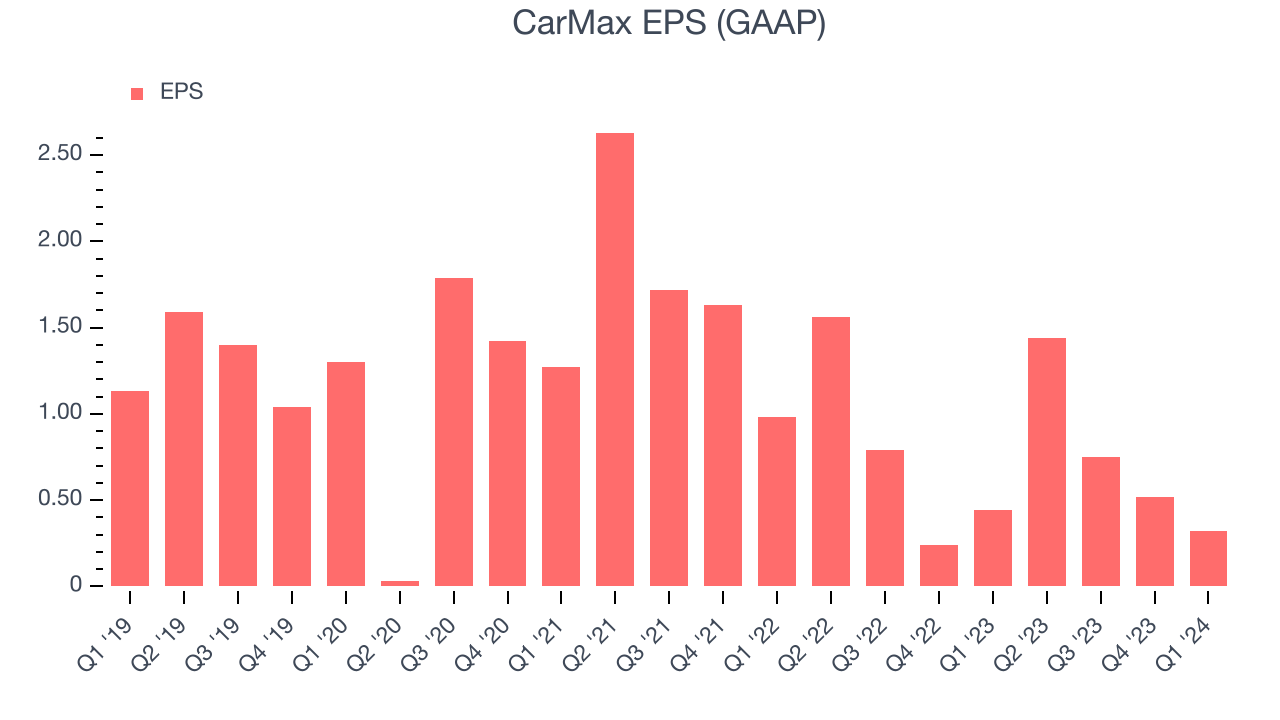
On the bright side, Wall Street expects the company's earnings to grow over the next 12 months, with analysts projecting an average 15.5% year-on-year increase in EPS.
Cash Is King
If you've followed StockStory for a while, you know that we emphasize free cash flow. Why, you ask? We believe in the end, cash is king, and you can't use accounting profits to pay the bills.
CarMax's free cash flow came in at $199.8 million in Q1, representing a 3.6% margin and flipping from negative in the same quarter last year to positive this quarter. Seasonal factors aside, this was great for the business.
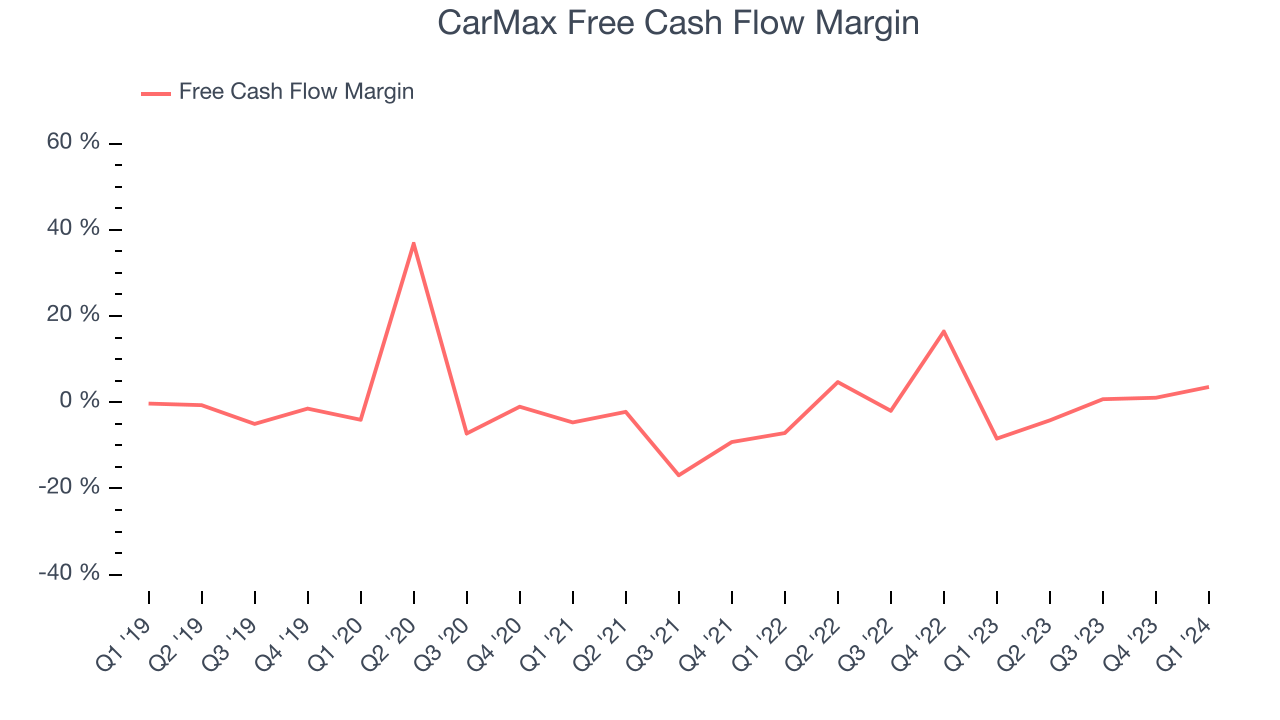
Over the last eight quarters, CarMax has shown mediocre cash profitability, putting it in a pinch as it gives the company limited opportunities to reinvest, pay down debt, or return capital to shareholders. Its free cash flow margin has averaged 1.5%, subpar for a consumer retail business. Furthermore, its margin has averaged year-on-year declines of 2.9 percentage points.
Return on Invested Capital (ROIC)
EPS and free cash flow tell us whether a company was profitable while growing revenue. But was it capital-efficient? A company’s ROIC explains this by showing how much operating profit a company makes compared to how much money the business raised (debt and equity).
CarMax's five-year average ROIC was 4%, somewhat low compared to the best retail companies that consistently pump out 25%+. Its returns suggest it historically did a subpar job investing in profitable business initiatives.
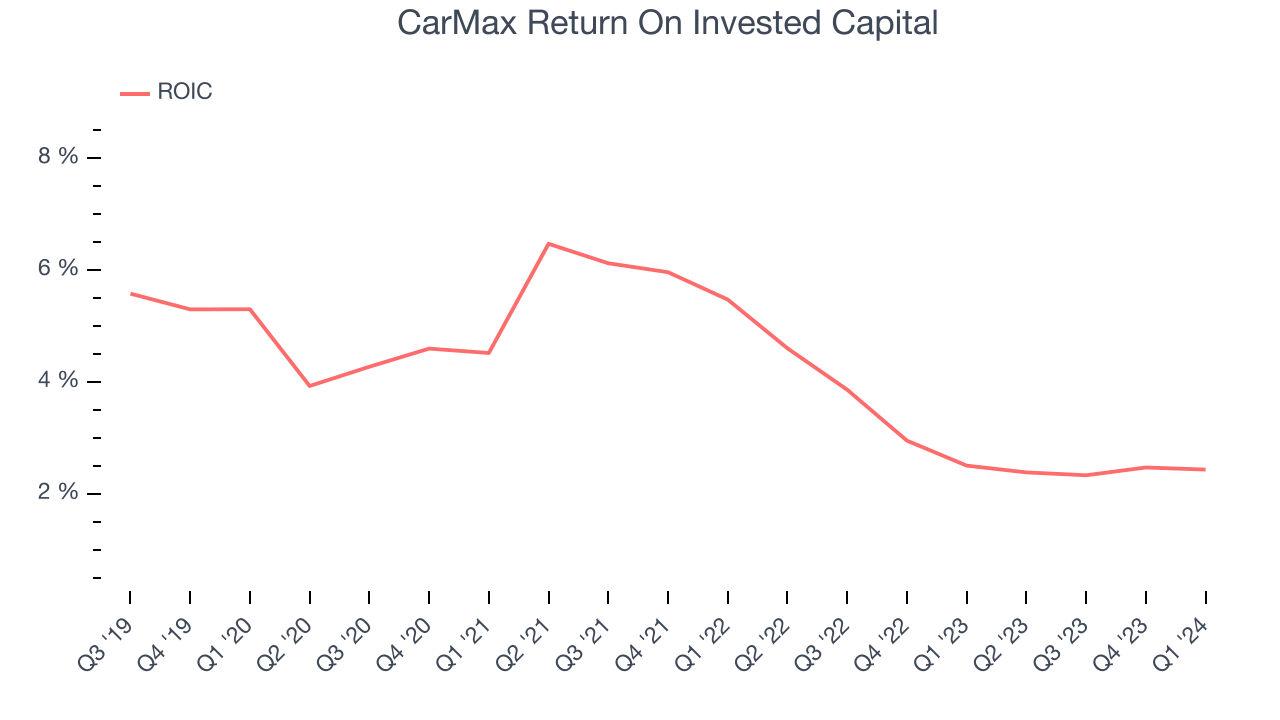
The trend in its ROIC, however, is often what surprises the market and drives the stock price. Unfortunately, CarMax's ROIC averaged 2.4 percentage point decreases over the last few years. Paired with its already low returns, these declines suggest the company's profitable business opportunities are few and far between.
Balance Sheet Risk
Debt is a tool that can boost company returns but presents risks if used irresponsibly.
CarMax's $19.31 billion of debt exceeds the $574.1 million of cash on its balance sheet. Furthermore, its 19x net-debt-to-EBITDA ratio (based on its EBITDA of $963.8 million over the last 12 months) shows the company is overleveraged.
At this level of debt, incremental borrowing becomes increasingly expensive and credit agencies could downgrade the company’s rating if profitability falls. CarMax could also be backed into a corner if the market turns unexpectedly – a situation we seek to avoid as investors in high-quality companies.
We hope CarMax can improve its balance sheet and remain cautious until it increases its profitability or reduces its debt.
Key Takeaways from CarMax's Q1 Results
We struggled to find many strong positives in these results. Its revenue and gross margin missed analysts' expectations, leading to an EPS miss. Furthermore, CarMax's management team pushed its goal of 2 million vehicles sold annually to 2026-2030, citing uncertainty in the recovery timing of the used car market. Overall, this was a mediocre quarter for CarMax. The company is down 12.6% on the results and currently trades at $69.17 per share.
Is Now The Time?
CarMax may have had a tough quarter, but investors should also consider its valuation and business qualities when assessing the investment opportunity.
We cheer for all companies serving consumers, but in the case of CarMax, we'll be cheering from the sidelines. Its revenue growth has been a little slower over the last five years, and analysts expect growth to deteriorate from here. And while its projected EPS for the next year implies the company's fundamentals will improve, the downside is its relatively low ROIC suggests it has struggled to grow profits historically. On top of that, its gross margins make it more challenging to reach positive operating profits compared to other consumer retail businesses.
CarMax's price-to-earnings ratio based on the next 12 months is 22.3x. While we've no doubt one can find things to like about CarMax, we think there are better opportunities elsewhere in the market. We don't see many reasons to get involved at the moment.
Wall Street analysts covering the company had a one-year price target of $84.92 per share right before these results (compared to the current share price of $69.17).
To get the best start with StockStory, check out our most recent stock picks, and then sign up to our earnings alerts by adding companies to your watchlist here. We typically have the quarterly earnings results analyzed within seconds of the data being released, and especially for companies reporting pre-market, this often gives investors the chance to react to the results before the market has fully absorbed the information.
